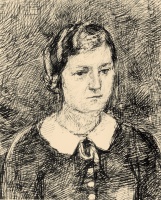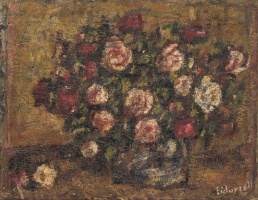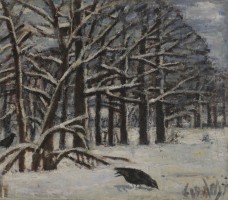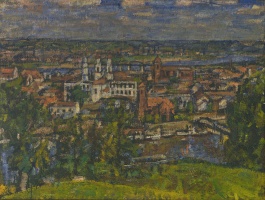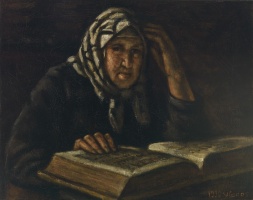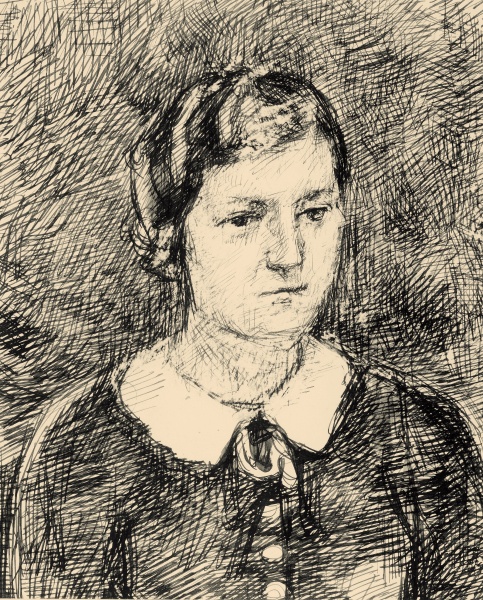

Double portrait of a girl
| Author: | Vladas Eidukevičius (1891–1941) |
Vladas Eidukevičius (1891–1941), a painter, was born on 9 August 1891 in Kaunas. He and his parents then took up residence in Riga. When he was 15, he entered B. Borchert’s art studio. Later he attended art school in Riga and was taught by J. Rosenthal. During 1910–1912 he lived in St. Petersburg and Moscow where he visited museums. In 1913–1914 he studied at the Munich Academy of Art, but because the war had interrupted his studies, he moved to Berlin and later, to Heidelberg. In 1918 he returned to Riga for a short period. He was a member of the Independent Artists’ Society of Latvia and participated in its exhibitions. In 1920–1940 he travelled much in Europe: he visited France, Holland, Belgium, Sweden, Italy, Switzerland, Germany, Spain and Corsica. In 1922 and 1929 he held private exhibitions in Riga, in 1928 in Paris, in 1932 in Kaunas and in 1933 in Klaipėda. From 1932 he lived in Kaunas. On 22 June 1941 he tragically died in Kaunas under unclear circumstances.
Vladas Eidukevičius was an exceptionally talented artist, a man of original thought and an art fanatic whose every work is of a particular value as it reflects the spirit of the artist. He built the composition of his works based on the laws of classical art, but painted in a modern manner using new artistic ways of expression in painting. V. Eidukevičius succeeded in finding a balance between the classical legacy and impressionistic expression. He was fond of landscapes and attempted to render the impressions of mood and space in them. He used an original way to create the illusion of space: he painted the foreground with large colourful patches and pastozic strokes (the manner of painting with thick, factured strokes – N. T.) and painted the background with smaller patches and finer strokes, and then covered the whole surface with “dry” strokes, which create a vibrant facture like the impressionist manner.
Source: Valiunas Ellex (LAWIN until 2015) art album: THE WORLD OF LANDSCAPES I (2010). Compilers Nijolė Tumėnienė, Dalia Tarandaitė, Jurgita Semenauskienė. Text author Nijolė Tumėnienė.

Vladas Eidukevičius (1891–1941), a painter, was born on 9 August 1891 in Kaunas. He and his parents then took up residence in Riga. When he was 15, he entered B. Borchert’s art studio. Later he attended art school in Riga and was taught by J. Rosenthal. During 1910–1912 he lived in St. Petersburg and Moscow where he visited museums. In 1913–1914 he studied at the Munich Academy of Art, but because the war had interrupted his studies, he moved to Berlin and later, to Heidelberg. In 1918 he returned to Riga for a short period. He was a member of the Independent Artists’ Society of Latvia and participated in its exhibitions. In 1920–1940 he travelled much in Europe: he visited France, Holland, Belgium, Sweden, Italy, Switzerland, Germany, Spain and Corsica. In 1922 and 1929 he held private exhibitions in Riga, in 1928 in Paris, in 1932 in Kaunas and in 1933 in Klaipėda. From 1932 he lived in Kaunas. On 22 June 1941 he tragically died in Kaunas under unclear circumstances.
Vladas Eidukevičius was an exceptionally talented artist, a man of original thought and an art fanatic whose every work is of a particular value as it reflects the spirit of the artist. He built the composition of his works based on the laws of classical art, but painted in a modern manner using new artistic ways of expression in painting. V. Eidukevičius succeeded in finding a balance between the classical legacy and impressionistic expression. He was fond of landscapes and attempted to render the impressions of mood and space in them. He used an original way to create the illusion of space: he painted the foreground with large colourful patches and pastozic strokes (the manner of painting with thick, factured strokes – N. T.) and painted the background with smaller patches and finer strokes, and then covered the whole surface with “dry” strokes, which create a vibrant facture like the impressionist manner.
Source: Valiunas Ellex (LAWIN until 2015) art album: THE WORLD OF LANDSCAPES I (2010). Compilers Nijolė Tumėnienė, Dalia Tarandaitė, Jurgita Semenauskienė. Text author Nijolė Tumėnienė.






